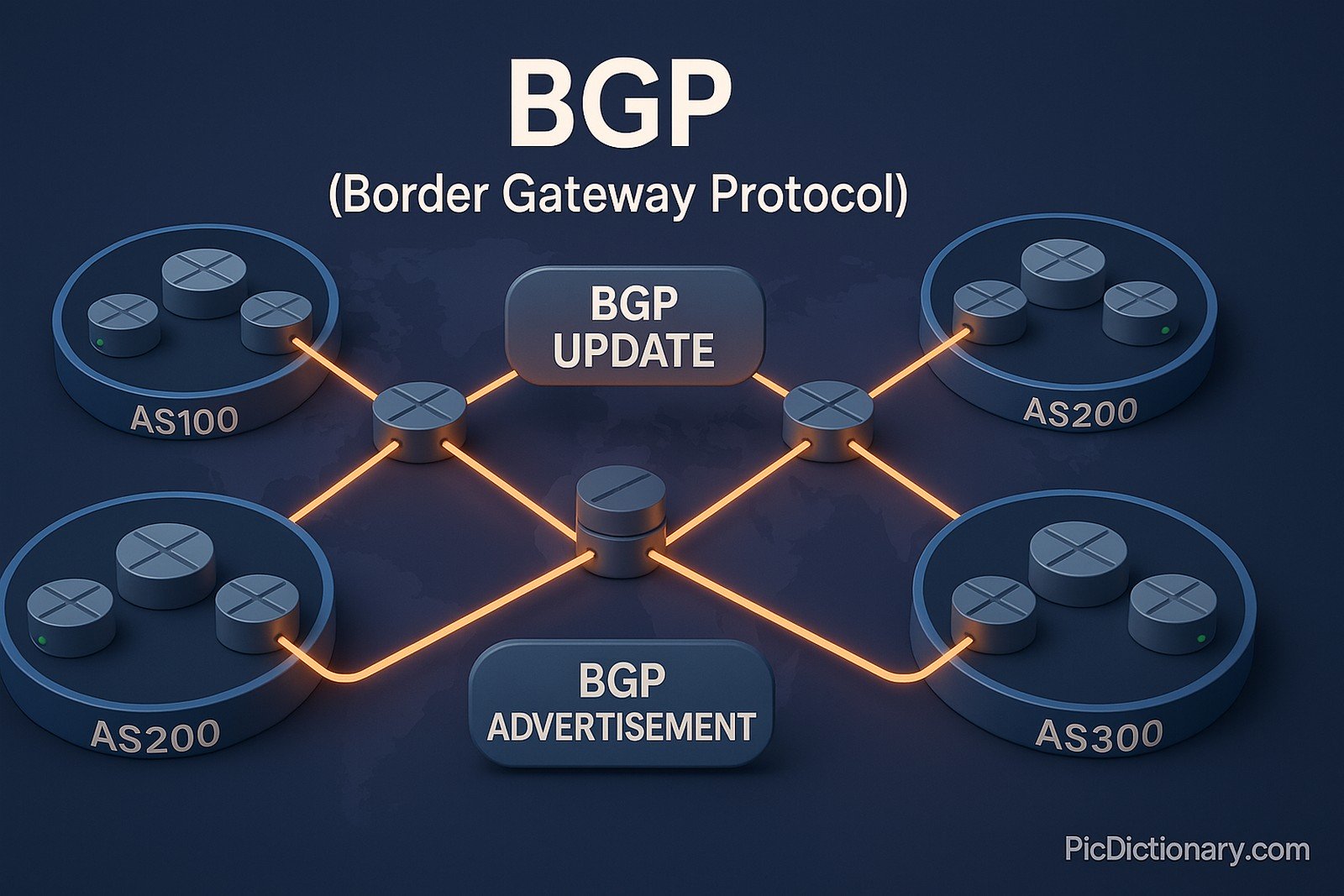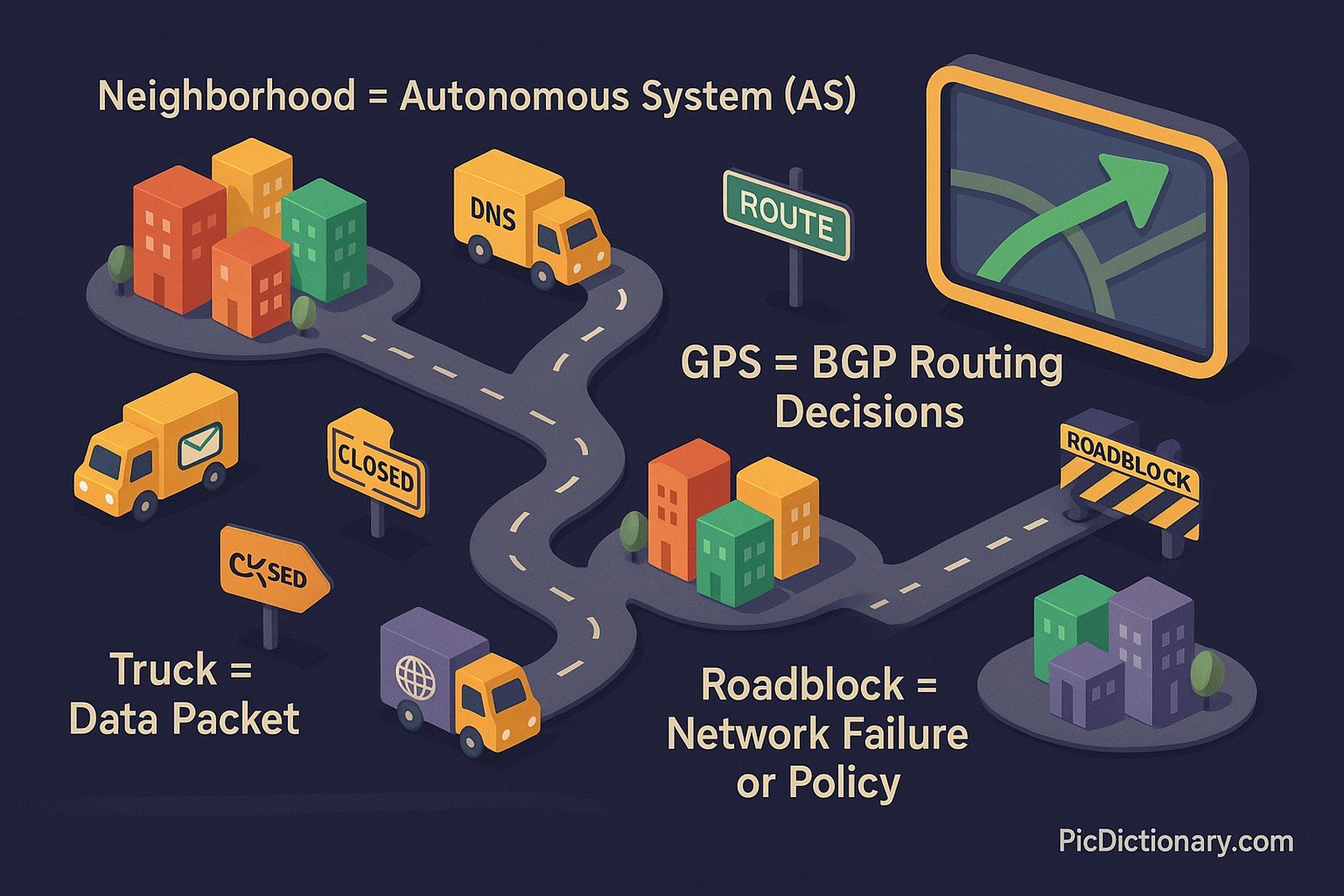BGP (Border Gateway Protocol)

Quick Navigation:
- BGP Definition
- BGP Explained Easy
- BGP Origin
- BGP Etymology
- BGP Usage Trends
- BGP Usage
- BGP Examples in Context
- BGP FAQ
- BGP Related Words
BGP Definition
Border Gateway Protocol (BGP) is a standardized exterior gateway protocol used to exchange routing information between autonomous systems (AS) on the internet. It is fundamental to the operation of the internet, determining the best paths for data transmission by analyzing network policies and path attributes. BGP relies on TCP for reliable transmission and can handle large-scale networks with complex routing rules.
BGP Explained Easy
Imagine the internet as a huge city with many neighborhoods. Each neighborhood has its own delivery routes, but delivery trucks need to know the best way to reach other neighborhoods. BGP is like the GPS for these trucks, helping them find the fastest, safest roads, even when there are roadblocks or detours.
BGP Origin
BGP was introduced in 1989 as a replacement for the older Exterior Gateway Protocol (EGP). It was developed by Yakov Rekhter and Kirk Lougheed, who recognized the need for a scalable and flexible protocol that could handle the growing internet.
BGP Etymology
The name derives from its role as a “gateway” protocol that operates across autonomous system borders, facilitating communication and routing between them.
BGP Usage Trends
BGP usage has expanded with the growth of global internet infrastructure. It plays a vital role in content delivery networks (CDNs), cloud services, and data centers. With increasing focus on cybersecurity, BGP security measures such as RPKI and BGP monitoring are becoming more common to prevent route hijacking and misconfigurations.
BGP Usage
- Formal/Technical Tagging:
- Networking
- Internet Protocols
- Routing - Typical Collocations:
- "BGP route announcement"
- "BGP session"
- "BGP route hijacking"
- "BGP configuration"
BGP Examples in Context
- Network engineers use BGP to ensure reliable connectivity between different ISPs.
- Major cloud providers rely on BGP to manage traffic across their global data centers.
- BGP is employed in DDoS mitigation strategies to reroute malicious traffic.
BGP FAQ
- What is BGP?
BGP is a protocol used to exchange routing information between different autonomous systems on the internet. - How does BGP work?
BGP uses path attributes and policies to determine the best route for data transmission between networks. - Is BGP only used by ISPs?
No, large organizations, cloud providers, and data centers also use BGP for routing management. - What are BGP route hijacks?
BGP hijacks occur when false routing information redirects traffic to unintended destinations, often for malicious purposes. - Can BGP fail?
Yes, misconfigurations or malicious actions can cause BGP disruptions, leading to outages or routing issues. - What is BGP peering?
BGP peering refers to the establishment of a connection between two autonomous systems to exchange routing information. - What are BGP communities?
BGP communities are tags attached to routes that influence routing decisions based on network policies. - Is BGP secure by default?
No, BGP lacks built-in security, so additional measures like RPKI and route filtering are implemented to enhance its security. - How is BGP monitored?
BGP is monitored using tools that track route changes, anomalies, and potential hijacks in real time. - Why is BGP important for the internet?
BGP ensures that data can traverse complex global networks efficiently and reliably.

BGP Related Words
- Categories/Topics:
- Networking
- Internet Protocols
- Routing
- Internet Security
Did you know?
In 2008, a major YouTube outage occurred when Pakistan Telecom accidentally announced incorrect BGP routes, leading to global traffic misdirection. This event highlighted the critical importance of proper BGP configurations and security.
PicDictionary.com is an online dictionary in pictures. If you have questions or suggestions, please reach out to us on WhatsApp or Twitter.Authors | Arjun Vishnu | @ArjunAndVishnu

I am Vishnu. I like AI, Linux, Single Board Computers, and Cloud Computing. I create the web & video content, and I also write for popular websites.
My younger brother, Arjun handles image & video editing. Together, we run a YouTube Channel that's focused on reviewing gadgets and explaining technology.



Comments powered by CComment